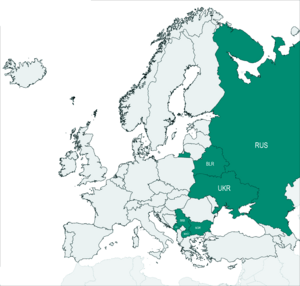Eastern Orthodox Slavs facts for kids

Eastern Orthodox Slavic countries
|
|
| Total population | |
|---|---|
| 215,789,388 (2015) | |
| Regions with significant populations | |
| Eastern and Southeastern Europe | |
| Languages | |
| East Slavic South Slavic |
|
| Religion | |
| Eastern Orthodox Church | |
| Related ethnic groups | |
| Other Slavs |
The Eastern Orthodox Slavs are a group of Slavic people who mainly follow the Eastern Orthodox Church. This Christian faith spread to Eastern Europe a long time ago. It came from the Byzantine Empire, which was a powerful empire in the past. Many Slavic countries still follow this faith today.
These people live in different parts of Eastern Europe. You can find them in:
- A large area including most of Russia, Ukraine, and Belarus.
- A smaller area called Kaliningrad Oblast, which is part of Russia but separate from the main country.
- A medium-sized area in the south, including Bulgaria and some countries that used to be part of Yugoslavia.
They live from the Baltic Sea in the northeast all the way to the Carpathian and Balkan Mountains in the southeast and southwest. You can also find many Eastern Orthodox Slavs in other parts of the world, like Siberia in North Asia and in the Americas.
Most Eastern Orthodox Churches that use Slavic languages for their services follow the Julian calendar. This is an older calendar. They use it to figure out when Easter is celebrated each year. The only exception is the Bulgarian Orthodox Church.
Countries with Eastern Orthodox Slavs
Many Slavic countries have a large number of Eastern Orthodox followers. Here are some of them:
Other Slavic countries, like Bosnia and Herzegovina and Croatia, also have some Eastern Orthodox people. You can find smaller groups in West Slavic countries too, such as Slovakia, Poland, and the Czech Republic.
Important Churches
The Eastern Orthodox Church is made up of many independent churches. These are called "autocephalous" churches, which means they can choose their own leaders. Some of the main Eastern Orthodox Churches for Slavic people include:
- Russian Orthodox Church
- Orthodox Church of Ukraine
- Serbian Orthodox Church
- Bulgarian Orthodox Church
- Polish Orthodox Church
- Czech and Slovak Orthodox Church
A Look at History
Bulgaria became a very important center for Slavic Eastern Orthodoxy early on. In 864, Bulgaria became Christian. This helped it become a major cultural and learning center for Slavic Europe. This time is often called the "Golden Age" of medieval Bulgarian culture.
The Bulgarian Orthodox Church was recognized as independent in 870. This was the first time a Slavic church was given this special status. A very important event was the creation of the Cyrillic alphabet. This alphabet was developed at the Preslav Literary School. In 893, the Cyrillic alphabet became official, and church services began to be held in Old Church Slavonic, which was an early Slavic language.
In 918 or 919, the Bulgarian Patriarchate became the first independent Slavic Patriarchate. A Patriarchate is a very important church region led by a Patriarch. This status was officially recognized by the Patriarchate of Constantinople in 927.

